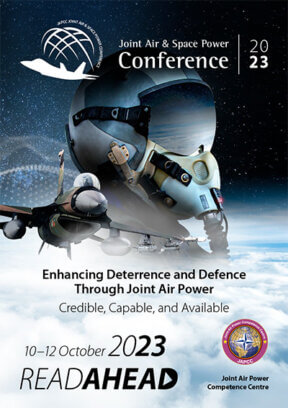The Challenge for Future Logistics
Logistics is the cornerstone of all NATO operations but is often a secondary planning discussion after the staff plans the execution portion of an operation. According to NATO doctrine (AJP-5), ‘Logistics frequently shapes the design of operations.’1 However, AJP-5 does not address logistics in operations planning until Course-of-Action (COA) analysis since ‘nations have the ultimate responsibility for equipping their forces.’2 Paraphrasing the doctrine, the staff will develop COAs to achieve the objective through operational art and design, determine if the Alliance possesses the correct capabilities to achieve the objective, adjust the plan if needed, and then the logistics planners attempt to estimate the time and quantity of resources required to get the needed capabilities in place and sustain the forces while in execution. However, without early logistics planning, this method can have dramatic negative impacts on operational plans when, after days or weeks of planning, the planning staff ascertains the nations cannot get all of the required capabilities to the locations the operators need or they can only sustain the operation for a fraction of the time required to achieve the objectives.
The ambiguity and complexity of logistical planning intensify when supporting future high-intensity, high-threat, and large-scale operations, to include Multi-Domain Operations (MDO). According to the definition released by Allied Command Transformation in March of 2023, MDO in NATO is ‘the orchestration of military activities, across all domains and environments, synchronized with non-military activities, to enable the Alliance to create converging effects at the speed of relevance.’3 In the Joint Airpower Competence Centre pamphlet, ‘All-Domain Operations in a Combined Environment,’ the preeminent NATO Centre of Excellence describes a future where multiple NATO nations execute synchronized operations across domains utilizing state-of-the-art Machine Learning (ML) and Artificial Intelligence (AI) to reduce the fog of war, speed up the Find, Fix, Track, Target, Engage, Assess, (F2T2EA) kill chain, and achieve operational and strategic effects.4 However, in every operation and especially highlighted by the initial failures of Russian Armed Forces attempting to seize the capital of Ukraine, Kyiv, in February and March of 2022, the logistics enterprise remains a critical component of operational concepts and must evolve and develop concurrently with the execution enterprise.
According to ACT, NATO and national logistics enterprises must be prepared to connect ‘the systems and expertise of national and non-military stakeholders, and be agile enough to integrate emerging technology that support the delivery of MDO.’5 However, the nature of logistics, being a mix of military, contracted, and civilian solutions presents very real difficulties in incorporating logistics into future military command and control and planning systems.
NATO Logistics as a National Capability
In 2014 and again in 2015, the North Atlantic Council (NAC) issued the Readiness Action Plan (RAP) and Political Guidance 2015 in response to the Russia-Ukraine conflict in Crimea. This guidance promoted, ‘the pursuit of collective logistics and broadens the logistics vision to provide NATO commanders the greatest flexibility on current and future missions by providing effective and efficient logistic support.’6
Currently, NATO logistics is a function of and limited by the capabilities of the member nations and are, ‘primarily a national (responsibility).’ According to NATO doctrine, there are four primary methods of multinational logistics support to an operation:
- Pre-planned mutual support, which are Mutual Support Agreements (MSAs) and cooperation between National Support Elements (NSEs) that are arranged bi- or multilaterally by NATO and/or nations.
- One nation formally provides the support and services to all or part of the multinational force as the Logistic Lead Nation (LLN) or the Logistic Role Specialist Nations (LRSN).
- One or more nations formally services all or part of the multinational force under the operational control of the joint force commander.
- One or more nations services all or part of the multinational force by forming a Multinational Logistic/Medical Unit (MLU/MMU).7
In all of these cases, either nations will supply and sustain with their own logistics or one or more member nations will provide the logistics capability, the nuances being who has command authority and under what agreement they will support. However, the limitations, and by extension the vulnerabilities, of the individual nations are ever present in NATO operations and may even be exaggerated by the increased stress of multinational operations.
The ‘Triple Constraint’ Challenge
Every commander desires fast, cheap, and abundant logistics when executing military operations. However, in the real world of trade-offs and compromises, a typical military logistics organization can achieve at most two of the three features and typically gets one. Compared to commercial air logistics such as FedEx or DHL, military logistics are much more complicated and more limited by transportation capacity than funding, forcing a trade between speed and volume. In general, increasing the speed of logistics normally means switching the mode of travel from surface and sea transport to air, increasing the cost and reducing the volume and weight of the shipments.8
The logistics enterprise operates within the constraints of the ‘Project Management Triangle’, or triple constraint. In short, this theory of constraints contends:
- the quality of work is constrained by the project’s budget, deadlines and scope (features);
- the project manager can trade between constraints;
- changes in one constraint necessitate changes in others to compensate, or quality will suffer.9
For military logistics, the first constraint can be modified to, ‘The quality of the logistics is constrained by the nation’s budget, delivery speed, and quantity.’ On one end of the spectrum, the most cost-effective logistics deliver an immense amount of material very slowly, typically via rail and sealift. On the other end of the spectrum, logistics theoretically can move a tiny amount very quickly at high cost. A few years ago, the United States Transportation Command, the command responsible for global logistics for the United States, held a conference with more than forty commercial executives where the commanding general at the time, General Lyons, highlighted the future capability to, ‘eventually move cargo through space to anywhere on the planet in an hour’.10 Although this level of speed would be reserved only for the absolute pinnacle of priority cargo, it demonstrates the theoretical limit of the speed, cost, and volume triad.
The vision for NATO leadership is for the logistics enterprise to increase ‘flexibility on current and future missions by providing effective and efficient logistic support‘. To have such a vision for improvement indicates that past operations were impaired, at least in part, by a rigidity in support or failure to provide effective and/or efficient solutions. Future solutions must be flexible to prioritize and reprioritize support to meet operational requirements. As the Alliance moves from conventional planning by traditional joint components to MDO, planned simultaneously across five domains, the complexity and stress on the logistics enterprise will only increase.
NATO Logistics in the Future
What impacts do future high-intensity, high-threat, and large-scale operations have on NATO logistics? The Alliance Concept reiterates that MDO-trained staffs will execute ‘synchronized activities that create effects at scale and speed to produce collective results that are greater than the sum of their individual parts.’ As NATO increases the speed of execution of the kinetic fight, reducing the time from target detection to employment of a weapon or force, and improving the operational and strategic impact of those decisions, the logistics side of the Alliance must be in place and capable to support.
In the future, national logistics support systems, using ML and AI, may be able to automatically and pre-emptively place an order for the required weapon or supporting equipment and match it with the necessary transportation method to achieve the required delivery date. This capability would function similarly to Amazon’s Anticipatory Shipping.11 According to Forbes Magazine, ‘Amazon collects troves of valuable data about its customers’ preferences and habits. With anticipatory shipping, the idea is to use that data to predict what customers want and then ship the products automatically.’12 Specifically, the patent includes:
‘Packaging one or more items as a package for eventual shipment to a delivery address, selecting a destination geographical area to which to ship the package, shipping the package to the destination geographical area without completely specifying the delivery address at the time of shipment, and while the package is in transit, completely specifying the delivery address for the package.’
For logistics in this environment, coupling future command and control systems with the required in-transit visibility capability will give commanders unprecedented flexibility to execute the operations necessary to achieve the desired strategic effects.
For military logistics, this means placing an order for forces or equipment to service a target or operation and simultaneously ordering replacement parts, expected maintenance support equipment, and/or follow-on weapons. Furthermore, if programmed with sufficient and correct historical execution data and logistics support plans, these national systems could theoretically anticipate operational changes as they are occurring and could then adjust the flow of personnel and equipment to meet the changing operational need.
Conclusion and Future of NATO Logistics
The current logistics systems of the Alliance’s militaries are not designed for the necessary level of flexibility and speed to meet the needs of the future high-intensity, high-threat environment. Even if systems existed to receive logistics orders, check stock levels, identify a sourcing solution, and build multi-modal movement plans, NATO logistics would undoubtedly be faced with a lack of capacity or timeliness on the transportation side, even with a significant reliance on civilian or contract solutions.
NATO logistics must rapidly evolve to lead and develop the future of logistics in a way that enables operations in a high-intensity, high-threat conflict and provides new capabilities to improve ‘push logistics’ instead of being reactive. In an article on the Defence Visual Information Distribution Service (DVIDS), Gen. Joseph L. Votel, USA (ret.) stated, ‘In a renewed era of great-power competition, logistics cannot be overlooked.’13 As the Alliance seeks to transform integration across domains and simultaneously incorporate emerging technology, innovation must also occur within the logistics enterprise. From commercial integration with suppliers and transportation providers, to systems providing in-transit visibility, to multi-modal delivery of personnel and equipment, current obstacles to effective logistics may become barriers to successful future operations.












